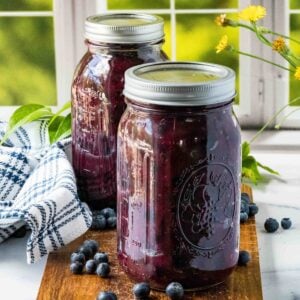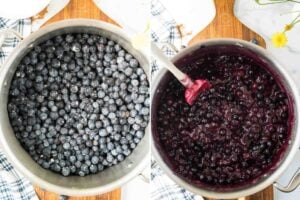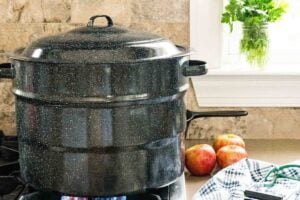How To Make Canned Blueberry Pie Filling and Easily Preserve Summer in a Jar
Whether you’re craving a classic blueberry pie, a fruity addition to your cheesecake, or a swirl of goodness in your vanilla ice cream, this easy-to-follow blueberry pie filling recipe is perfect. Get ready to enjoy the taste of summer all year round.
Homemade Blueberry Pie Filling for Canning

Equipment
- Large canning pot with rack (see my canning recommendations here)
- Canning jars (4 quart size), lids, and rings
Ingredients
- 14 cups fresh blueberries washed and drained
- 2¾ cups granulated sugar
- 1 cup ClearJel a cornstarch derivative used for canning
- 2½ cups cold water
- ½ cup bottled lemon juice
- ¼ teaspoon ground cinnamon
- ¼ teaspoon ground nutmeg
Want To Save This For Later?
You'll join my email list which you will love. And if you don't, unsubscribe in one click. ❤️
Instructions
- Prepare for canning: Heat your jars by boiling in a large canning pot for 10 minutes. Warm your lids in a small pot over low heat. Keep everything hot until ready to use.
- Make the syrup: In another large pot, whisk together the sugar and ClearJel. Add the water, and whisk until smooth. Over medium heat, bring the mixture to a boil, stirring constantly. Once boiling, add the lemon juice, cinnamon, and nutmeg and return to a boil for 1 minute, continuing to stir.

- Add the blueberries. Add the fruit and stir gently to mix. Return to a boil, then remove from heat. They will quickly change color from the heat in the pan, do not continue to cook!

- Fill the jars: Using a canning funnel and ladle, fill each jar with the blueberry filling, leaving a 1-inch headspace at the top. Wipe the rims of the jars with a clean cloth. Apply the lids and screw on the rings until they are fingertip-tight.

- Process the jars: Place the jars in the canning pot, ensuring they are completely covered with water. Bring to a boil and process quart jars for 30 minutes. Remove the jars and let them cool.

- Check the seals: Once the jars have cooled, check the seals to ensure they have properly sealed. Lids should not flex up and down when pressed in the center. Any jars that do not seal properly should be refrigerated and used first.
Notes
When you’re ready to use the filling, simply empty the contents of one jar into a pre-baked pie crust, add a top crust if desired, and bake until the crust is golden and the filling is bubbly. Enjoy!
Oh, this blueberry pie filling recipe? It’s an absolute gem in our kitchen. Seriously, we’re all about those cozy, homey vibes, and nothing screams comfort quite like a homemade pie. We always have plenty of our favorite pie crust in the freezer, and now having pie filling ready to go was a game changer.

It’s got just the right amount of sweetness, with a hint of cinnamon and nutmeg that elevates it to another level. Plus, being able to say it’s made with our very own blueberries? Even better! I hope you find it as delightful and handy as we do.
Key Ingredients and Tools
In this blueberry pie filling recipe, a couple of ingredients stand out not just for their role in the recipe but also for where you might find them and possible substitutions. Here’s a closer look at them:

- ClearJel. A cornstarch derivative used for canning, ClearJel is the thickener that ensures your pie filling has the perfect consistency. It’s not as commonly found on the shelves as regular cornstarch, but you can usually locate it in stores specializing in canning supplies or online. Its ability to withstand high temperatures and maintain consistency during canning makes it irreplaceable in this recipe. If you’re in a pinch, there’s no perfect substitute for ClearJel, especially for canning purposes, because alternatives like cornstarch, flour, or tapioca might not hold up as well through the canning and storage process.
- Bottled Lemon Juice. This ingredient is critical for ensuring the pie filling’s safety and longevity. You can find bottled lemon juice in the condiment aisle of most grocery stores, near the vinegars and salad dressings. Its consistent acidity level is crucial for canning, making it a better choice than fresh lemon juice, whose acidity can vary.
Here are the essentials in terms of equipment:

- Large Canning Pot with Rack. This pot is essential for processing the jars in boiling water, which sterilizes them and seals the lids. The rack keeps the jars off the bottom of the pot to prevent breakage from direct heat.
- Canning Jars (Quart Size), Lids, and Rings. Quart-sized jars are perfect for storing enough pie filling for a pie or other dessert. The lids and rings are crucial for creating an airtight seal that preserves the filling.
- Canning Funnel. A canning funnel has a wide mouth that fits perfectly into the jars, making it easy to fill them with the blueberry filling without making a mess. It ensures cleanliness and efficiency, keeping the jar rims clean for a proper seal.
- Ladle. Used in conjunction with the funnel, a ladle helps you transfer the pie filling into jars. It’s important for controlling the flow and preventing spills.
Troubleshooting and Help
Yeah, definitely. If fresh blueberries aren’t in season or just not available, frozen blueberries work fine. No need to thaw them first; you can use them straight from the freezer. Just keep an eye on the mixture, as it might need a bit longer to come to a boil.
Can without it and add cornstarch right before you use the filling. Do not can with cornstarch; it is not safe!
After the jars have cooled, press the center of each lid. If it’s sealed, the lid won’t pop back. If it does pop, that jar hasn’t sealed correctly. You can refrigerate it and use it first. It’s a simple check but super important for ensuring your pie filling is stored safely.
If you’ve got more questions, feel free to ask.
More Homemade Pie Fillings
All of these recipes are just as versatile and it it easy to create a homemade dessert.
- Apple Pie Filling
- Lemon Pie Filling (this one’s better if you don’t can it)
- How To Use Lemon Pie Filling
🔍 FAQs
The lemon juice plays a crucial role in maintaining the acidity level necessary for safe canning. It is not recommended to reduce the amount
After the jars have cooled, check the seals by pressing the center of the lids. Properly sealed lids should not flex up and down. Any jars that do not seal properly should be refrigerated and used first.
“Fingertip tight” is a term used in canning to describe the proper level of tightness when applying the canning jar lids and rings. It means that you should tighten the rings until they are comfortably snug using just your fingertips, without applying excessive force. The goal is to create a seal that is secure enough to prevent leaks during processing but not overly tight, allowing air to escape and creating a vacuum seal once the jars cool. It’s important not to overtighten the lids, as it can interfere with the sealing process.
“Fingertip tight” is a term used in canning to describe the proper level of tightness when applying the canning jar lids and rings. It means that you should tighten the rings until they are comfortably snug using just your fingertips, without applying excessive force. The goal is to create a seal that is secure enough to prevent leaks during processing but not overly tight, allowing air to escape and creating a vacuum seal once the jars cool. It’s important not to overtighten the lids, as it can interfere with the sealing process
Next time you find yourself with a bounty of blueberries or just craving something sweet and homemade, give this recipe a try. Happy canning, and enjoy the fruits of your labor.

By Katie Shaw

Katie shares simple, reliable recipes from her home in Virginia, where she lives with her husband, three daughters, a chocolate lab, and over thirty chickens.








How much time if using pint jars
I always just reduce by 5 min but to be honest you could probably go lower.
Just canned my blueberries today and love how they look. I am sure they will taste good too.